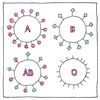Karl Landsteiner
medicine

|
Blood groups
Karl Landsteiner was the first to realize that to make human blood transfusions safe you don’t put lambs blood into a human as Jean-Baptiste Denys and Richard Lower had done, and you don’t just use any willing donor as James Blundell and Samuel Armstrong Lane had done, but you test whether the donor’s blood coagulates the recipient’s. * Antigens on the surfaces of blood cells are inherited according to Mendel’s laws. Some people have one antigen, some people have another antigen, some people have both of these antigens (universal recipients), and some people have neither (universal donors). If a person whose blood has the first antigen receives blood with the second antigen, the result can be sudden death.
Not so simple
Human red blood cells express more than two antigens, but this was not known until 1937. Now over six hundred blood-group antigens are recognized. Although some are rare some are more common, in some parts of the world, than the A, B, and Rhesus antigens, Blood connections like the familiar smell of home are not necessarily all imaginary. Mix in a little influenza virus or E. coli into a family or village and the people might develop a common immunity expressed as the A or B antigen. If your blood is type O then your family is three times more likely to have started in the Americas than in China.
Blood ties
I. ’Swounds! II. Two of one flesh. III. The mother’s hair, the father’s beard and baldness. IV. A lost tribe of Israel did not settle in the new world; the indigenous people build large towns, developed specialized knowledge and skills, and had common customs and laws. V. Inherit a bond, or rebel against everything, you are what you love, you are what you hate. VI. You are a host of miniscules expressing complex and contrary directions.



In addition to saving lives of people receiving blood transfusions, blood groups have been used in forensic and paternity cases, and, before DNA testing, to trace human migrations.
The medieval expression “’Swounds” is a corruption of the phrase “God’s wounds,” referring impolitely to the blood of Jesus on the cross, but I mean it to express having distant and obscure origins, divine or sacreligious.
See also in The book of science:
Readings in wikipedia: